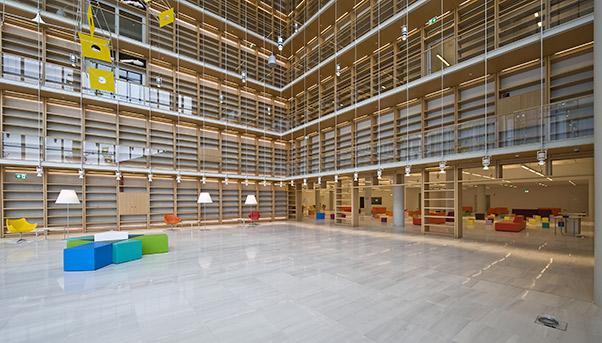Hidden under the perfect geometry of glass and cement that gives the Stavros Niarchos Foundation Cultural Center (SNFCC) its shape, reside the two pearls of the structure that gives it value and meaning.
They are the National Library of Greece and the Greek National Opera, separated by an external Agorà and sided by a long canal that stretches towards the sea.
Architectural vision and innovative engineering were put to the service of these two pearls to enable them to express their artistic and cultural strengths at the upmost. The spectacular glass facades that rise 24 meters in height let the right amount of light illuminate the library’s 750,000 books, to which are added other 1.250.000 or so held in an archive. This would lead to the library having more than two million books. The space is boundless and fascinating with white and grey as the dominant colours, contrasted by the warmth of the wood of the shelves and the bright yellow, green, red and purple of the sofas where visitors can sit to consult their books. At the upper floor is a reading room equipped with Internet connection and computer stations. The surrounding walls are filled with books where even the choice of wood was not casual: each piece of wood comes from a certified forest, located in the United States. All of this shows how the SNFCC is, above all else, a sustainable project.
Outside the library, the sun strikes the Agorà and its white Dionysus marble that covers the entire area, while the walls of glass on the right side resemble a shining canyon. From here is the entrance to the second building that houses the Greek National Opera, an experimental theatre, a rehearsal room for the orchestra, four practice rooms for dancers and many other spaces destined to musical and theatrical performances.

The new Cultural Center in Greece: Joining Innovation with Culture
But perhaps the opera hall itself (which can accomodate1,400 spectators) is the most effective symbol of this bond between technical skill and art. Inside, the dominant colour comes from the purple seats and the cherry wood. Together they bring warmth and tradition and a sense of prestige to the hall. But behind this beautiful façade, technology is everywhere: from the stage that moves electronically to allow for an infinite number of scene changes to the spectators’ seats, where each one is fitted with a monitor that can project the lyrics of an opera during its performance.
Technology and innovation is found elsewhere, too, where challenges were overcome by research into perfect acoustics and the ability to respond to tremors.
«Even the walls of the building are a unique formation,” says Sergio Roberti, head of Salini Impregilo Terna JV’s technical department. “They are in fact formed by an internal wall that can be made of either brick… or concrete, and an external wall of concrete (the visible one) that can move on a Teflon slide to waver in case of a tremor».The entire structure, meanwhile, rests on a sophisticated seismic isolators.
«Both buildings that house the opera and the library rest on seismic restraints, which allow for a movement of 30 centimetres in case of a tremor», says Gianni Botteon of Salini Impregilo who served as SNFCC’s project manager. «Due to the enormous size of this anti-seismic support system, we had to get them tested at the University of San Diego, the top research centre in the world in this sector. We needed three years to conduct the tests and, in the end, the entire system was certified as anti-seismic».
All of this gives a sense of the project: a prodigy of technology put to the service of art and culture. It also respects the three fundamental pillars established by the Stavros Niarchos Foundation since the beginning of this grand adventure. Education, culture and sustainability are the three pillars on which the Centre is based, according to the Foundation, describing them as essential for helping the city and its people realize their full potential.

